
One of my favorite study subjects is of course myself. And when it comes to good ideas, I’ve come to notice over the years that the essence of a truly inspired idea forms in only a few seconds. This almost instantaneous process is usually triggered by exposure to a unique experience that provides the missing piece that completes a thought pattern in the making. Patterns in the making or simply incomplete patterns, are themselves the result of internalizing prior knowledge and experiences, which, for a creative individual, should be a continuous process. And so, the creative potential emerges at the intersection between patterns in the making and exposure to diverse experiences.
Now this entire paradigm is in strong contradiction with the standard strategic planning process, which assumes both a deterministic correlation between quality of an idea and time invested and that the production of a great idea can happen by a certain deadline. This is also where Wall Street predictions of future value based on quantifiable measures such as those tied to finance fail.
As I’ve already mentioned, my great ideas appear almost instantaneously, but also completely unpredictably. I cannot predict the occurance of the circumstance that triggers an experience which completes a mental pattern in the making. When this does indeed happen, the creative act is virtually instantaneous. Only after the creative act produces the essence of new value can a planning process be effective in ensuring that the potential new value is instantiated into a real and useful outcome.
Much akin to J.P. Morgan’s famous response to the question of what the stock market will do – it will fluctuate! -, I can say I am generally creative, but can’t guarantee the next idea will be brilliant, or when or how it will emerge. I can say that my best ideas came when there was the least pressure of a deadline, in other words when I am completely mentally relaxed. So in the case of creativity, I believe the more one plans for a good idea, the less likely that a good idea will result. A different way to say this is that an idea is an emergent, non-deterministic act, while planning assumes determinism, and indeed clings to it for dear life.
And yes, I will sigh again the next time I see one of those circular diagrams management consultants and educators love to show off (see the one in this post) but which have nothing whatsoever to do with how humans actually create. As a matter of principle, do yourself a favor and stay away from circular diagrams or step recipes for creativity. They will box you in quicker than you might think. And don’t punish yourself when a good idea stubbornly refuses to come on command! Take a break, do completely unrelated things for a while, and wait for the right context instead.
Photo credit here.
